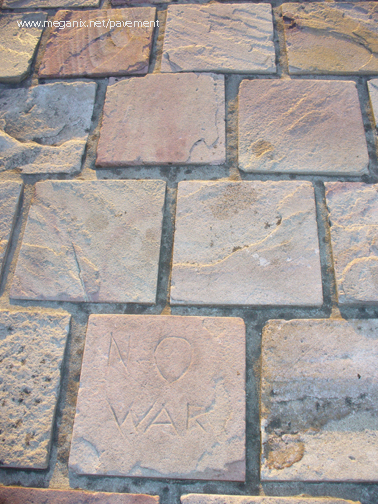 Sydney’s most famous pavement graffitist was Arthur Stace, a reformed no-hoper who walked the city’s streets writing the single copperplate word ‘Eternity’,  after being dramatically converted to Christianity in the 1930s. Some years after his death in 1967, Sydney artist Martin Sharp adopted his chalked word and began incorporating it into prints, posters, tapestries, postcards and T-shirts. Thanks to Sharp’s thirty-year Eternity industry, what was originally a religious message has become a product of popular culture. In 2001 ‘Eternity’ in Arthur Stace script was registered as a trademark by the City of Sydney because of its ‘iconic value … to the people of Sydney’.*
Sydney’s most famous pavement graffitist was Arthur Stace, a reformed no-hoper who walked the city’s streets writing the single copperplate word ‘Eternity’,  after being dramatically converted to Christianity in the 1930s. Some years after his death in 1967, Sydney artist Martin Sharp adopted his chalked word and began incorporating it into prints, posters, tapestries, postcards and T-shirts. Thanks to Sharp’s thirty-year Eternity industry, what was originally a religious message has become a product of popular culture. In 2001 ‘Eternity’ in Arthur Stace script was registered as a trademark by the City of Sydney because of its ‘iconic value … to the people of Sydney’.*
A replica of Stace’s one-word sermon is preserved in metal near a fountain below Town Hall Square. Unfortunately is it is hidden from most people except the patrons of a café whose outdoor chairs and tables surround it. It was raining the day I took this photograph – the cascades off the café umbrellas matched the cascading fountain.
Every now and then I come across ‘Eternity’ written in chalk by someone trying to imitate Stace. And a stencil artist in Melbourne has used the form of Stace’s word to write ‘Optimism’ on the pavements there.
(* I have written about chalk and pavement writing in ‘The Eternal City’, Meanjin 65(2), 2006, pp.139-146).
 At Federation Square in Melbourne Nearamnew is a public artwork that incorporates the cobblestone paving. According to the Federation Square website, it is a vast paving design with poetic text inscriptions where fragmented voices of historical and fictional characters can be deciphered in nine locations around the site.
At Federation Square in Melbourne Nearamnew is a public artwork that incorporates the cobblestone paving. According to the Federation Square website, it is a vast paving design with poetic text inscriptions where fragmented voices of historical and fictional characters can be deciphered in nine locations around the site. Sydney’s most famous pavement graffitist was Arthur Stace, a reformed no-hoper who walked the city’s streets writing the single copperplate word ‘Eternity’,
Sydney’s most famous pavement graffitist was Arthur Stace, a reformed no-hoper who walked the city’s streets writing the single copperplate word ‘Eternity’,